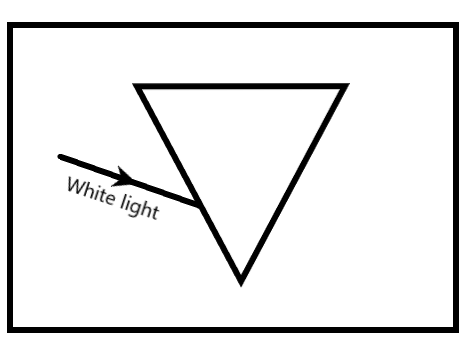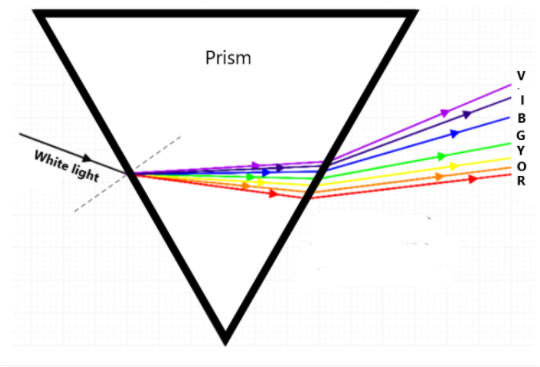
Complete the following diagram and compare the wavelengths of orange and violet lights.


Answer
564.6k+ views
Hint: We are given an inverted prism into which a beam of white light is incident. We know the phenomena that will occur as a result of this due to the difference in refractive indices of the air outside and the material with which the prism is made.
Complete step by step answer:
We know that when a light of certain wavelength passes from one medium to another, there is a chance of refraction at the boundaries of the two media. In case of a prism, there are two boundaries, one from air to the prism and the second from the prism to the air. We know that the refraction is dependent on the refractive indices of the two media.
In the given situation, a white light is moving from air to the prism, the air is a less-denser medium as compared to the prism as a result the ray gets closer to the normal of incidence. Also, the white light is a mixture of lights of different wavelengths. Each of the colours experiences a different amount of refraction.
Now, the light reaches the other end to pass from prism to air, i.e., from more-denser medium to less-denser medium. As a result, the beam gets away from the normal and propagates.
Also, the wavelength of each colour in white light affects the deflections at the two interfaces. A wave with higher wavelength is the least affected by deflection. So, we can say that the red light which has the longest wavelength in the visible spectrum will be the least bent and the blue will be the most bent. We can get the complete figure as –

We get the VIBGYOR as shown in the figure.
The wavelength of orange light is the longer that of the violet light.
Note:
The dispersion of the white light caused by the medium change is dependent on the wavelength of the light. The dispersive medium with higher refractive index causes the lights of different lights to split up causing the dispersion. This doesn’t happen in air because it is not a dispersive medium.
Complete step by step answer:
We know that when a light of certain wavelength passes from one medium to another, there is a chance of refraction at the boundaries of the two media. In case of a prism, there are two boundaries, one from air to the prism and the second from the prism to the air. We know that the refraction is dependent on the refractive indices of the two media.
In the given situation, a white light is moving from air to the prism, the air is a less-denser medium as compared to the prism as a result the ray gets closer to the normal of incidence. Also, the white light is a mixture of lights of different wavelengths. Each of the colours experiences a different amount of refraction.
Now, the light reaches the other end to pass from prism to air, i.e., from more-denser medium to less-denser medium. As a result, the beam gets away from the normal and propagates.
Also, the wavelength of each colour in white light affects the deflections at the two interfaces. A wave with higher wavelength is the least affected by deflection. So, we can say that the red light which has the longest wavelength in the visible spectrum will be the least bent and the blue will be the most bent. We can get the complete figure as –

We get the VIBGYOR as shown in the figure.
The wavelength of orange light is the longer that of the violet light.
Note:
The dispersion of the white light caused by the medium change is dependent on the wavelength of the light. The dispersive medium with higher refractive index causes the lights of different lights to split up causing the dispersion. This doesn’t happen in air because it is not a dispersive medium.
Recently Updated Pages
Master Class 12 English: Engaging Questions & Answers for Success

Master Class 12 Business Studies: Engaging Questions & Answers for Success

Master Class 12 Economics: Engaging Questions & Answers for Success

Master Class 12 Social Science: Engaging Questions & Answers for Success

Master Class 12 Maths: Engaging Questions & Answers for Success

Master Class 12 Chemistry: Engaging Questions & Answers for Success

Trending doubts
What are the major means of transport Explain each class 12 social science CBSE

Which are the Top 10 Largest Countries of the World?

Draw a labelled sketch of the human eye class 12 physics CBSE

Explain sex determination in humans with line diag class 12 biology CBSE

Explain sex determination in humans with the help of class 12 biology CBSE

Differentiate between homogeneous and heterogeneous class 12 chemistry CBSE




